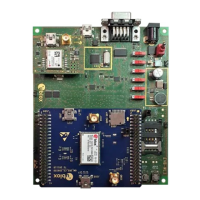SARA-R5 series - System integration manual
UBX-19041356 - R04 Design-in Page 97 of 118
C1-Public
2.13.2 Layout checklist
The following are the most important points for a simple layout check:
Check 50 nominal characteristic impedance of the RF transmission line connected to the ANT
port (cellular antenna RF interface).
Check cellular antenna trace design for regulatory compliance perspective (see section 4.2.3 for
FCC United States, section 4.3.2 for ISED Canada, and related section 2.4.2.3).
For SARA-R510M8S, check 50 nominal characteristic impedance of the RF transmission line
connected to the ANT_GNSS port (GNSS antenna RF interface).
Ensure no coupling occurs between the RF interfaces and noisy or sensitive signals (like SIM
signals and high-speed digital lines).
Optimize placement for minimum length of RF lines.
Check the footprint and paste mask designed for SARA-R5 series module as illustrated in
section 2.11.
VCC line should be enough wide and as short as possible.
Route VCC supply line away from RF lines / parts (refer to Figure 29) and other sensitive analog
lines / parts.
The VCC bypass capacitors in the picoFarad range should be placed as close as possible to the
VCC pins, in particular if the application device integrates an internal antenna.
Ensure an optimal grounding connecting each GND pin with application board solid ground layer.
Use as many vias as possible to connect the ground planes on multilayer application board,
providing a dense line of vias at the edges of each ground area, in particular along RF and high
speed lines.
Keep routing short and minimize parasitic capacitance on the SIM lines to preserve signal
integrity.
USB_D+ / USB_D- traces should meet the characteristic impedance requirement (90 differential
and 30 common mode) and should not be routed close to any RF line / part.
2.13.3 Antennas checklist
Antenna termination should provide 50 characteristic impedance with V.S.W.R at least less
than 3:1 (recommended 2:1) on operating bands in deployment geographical area.
Follow the recommendations of the antenna producer for correct antenna installation and
deployment (PCB layout and matching circuitry).
Ensure compliance with any regulatory agency RF radiation requirement, as reported in section
4.2.2 for FCC United States, in section 4.3.1 for ISED Canada, and in section 4.4 for RED Europe.
Ensure high isolation between the cellular antenna and any other antennas or transmitters
present on the end device.
For SARA-R510M8S, ensure high isolation between the cellular antenna and the GNSS antenna
(see also section 2.4.4)

